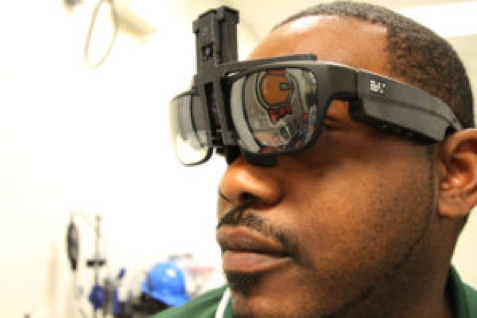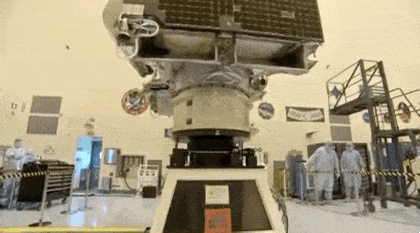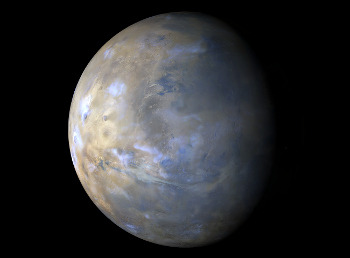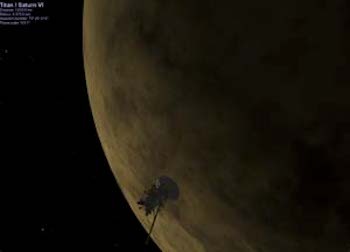Pluto, 2006 (Red Filter).

Pluto, 2006 (Red Filter).
Credit: NASA, ESA, A Stern, H Weaver and the HST Pluto Companion Search Team
More Posts from Thestarblaster-blog and Others

Paris syndrome is a mental disorder experienced mostly by Japanese tourists who are disappointed when they visit the city for the first time. The shock of Paris not living up to their expectations can cause depression, sweating, anxiety, dizziness, hallucinations and delusions of persecution. The Japanese Embassy in Paris has a 24-hour hotline for those needing help, and up to 20 tourists a year are hospitalized. The usual treatment for Paris syndrome is ‘to go home.’ Source Source 2 Source 3

Milky Way over Provence, France
js

The Cone Nebula from Hubble
js

47 Tucanae
10 Technologies That Are Changing the Game
Earlier this year, we hosted a Game Changing Technology Industry Day for the aerospace industry, and in October our engineers and technologists visited Capitol Hill showcasing some of these exciting innovations. Check out these technology developments that could soon be making waves on Earth and in space.
1. Wearable technology

With smartwatches, glasses, and headsets already captivating users around the world, it’s no surprise that the next evolution of wearable technology could be used by first responders at the scene of an accident or by soldiers on a battlefield. The Integrated Display and Environmental Awareness System (IDEAS) is an interactive optical computer that works for smart glasses.

It has a transparent display, so users have an unobstructed view even during video conferences or while visualizing environmental data.

And while the IDEAS prototype is an innovative solution to the challenges of in-space missions, it won’t just benefit astronauts – this technology can be applied to countless fields here on Earth.
2. Every breath they take: life support technologies
Before astronauts can venture to Mars and beyond, we need to significantly upgrade our life support systems. The Next Generation Life Support project is developing technologies to allow astronauts to safely carry out longer duration missions beyond low-Earth orbit.

The Variable Oxygen Regulator will improve the control of space suit pressure, with features for preventing decompression sickness. The Rapid Cycle Amine technology will remove carbon dioxide and humidity and greatly improve upon today’s current complex system.

3. 3-D printing (for more than just pizza)
New Advanced Manufacturing Technologies (AMT), such as 3-D printing, can help us build rocket parts more quickly and aid in building habitats on other planets.

These manufacturing initiatives will result in innovative, cost-efficient solutions to many of our planetary missions. Back in 2014, the International Space Station’s 3-D printer manufactured the first 3-D printed object in space, paving the way to future long-term space expeditions.

The object, a printhead faceplate, is engraved with names of the organizations that collaborated on this space station technology demonstration: NASA and Made In Space, Inc., the space manufacturing company that worked with us to design, build and test the 3-D printer.

4. Spacecraft landing gear
Large spacecraft entering the atmosphere of Mars will be traveling over five times the speed of sound, exposing the craft to extreme heat and drag forces. The Hypersonic Inflatable Aerodynamic Decelerator (HIAD) is designed to protect spacecraft from this environment with an inflatable structure that helps slow a craft for landing.

To get astronauts and other heavy loads to the surface safely, these components must be very strong. The inflatable consists of a material 15 times stronger than steel, while the thermal protection system can withstand temperatures over 1600°C.
5. From heat shield technology to firefighter shelters

For the Convective Heating Improvement for Emergency Fire Shelters (CHIEFS) project, we partnered with the U.S. Forest Service to develop safer, more effective emergency fire shelters for wild land firefighters.

Using existing technology for flexible spacecraft heat shields like HIAD, we are building and testing new fire shelters composed of stacks of durable, insulated materials that could help protect the lives of firefighters.

6. Robots and rovers
Real life is looking a bit more like science fiction as Human Robotics Systems are becoming highly complex. They are amplifying human productivity and reducing mission risk by improving the effectiveness of human-robot teams.

Our humanoid assistant Robonaut is currently aboard the International Space Station helping astronauts perform tasks.

A fleet of robotic spacecraft and rovers already on and around Mars is dramatically increasing our knowledge and paving the way for future human explorers. The Mars Science Laboratory Curiosity rover measured radiation on the way to Mars and is sending back data from the surface.

This data will help us plan how to protect the astronauts who will explore Mars.

Future missions like the Mars 2020 rover, seeking signs of past life, will demonstrate new technologies that could help astronauts survive on the Red Planet.

7. Robotic repairs
Currently, a satellite that is even partially damaged cannot be fixed in orbit. Instead, it must be disposed of, which is a lot of potential science lost.

Satellite Servicing technologies would make it possible to repair, upgrade, and even assemble spacecraft in orbit using robotics.

This can extend the lifespan of a mission, and also enable deeper space exploration.

Restore-L, set to launch in 2020, is a mission that will demonstrate the ability to grab and refuel a satellite.
8. Low-cost spacecraft avionics controllers
Small satellites, or smallsats, are quickly becoming useful tools for both scientists and industry. However, the high cost of spacecraft avionics—the systems that guide and control the craft—often limits how and when smallsats can be sent into orbit by tagging along as payloads on larger launches.

Using Affordable Vehicle Avionics (AVA) technology, we could launch many more small satellites using an inexpensive avionics controller. This device is smaller than a stack of six CD cases and weighs less than two pounds!
9. Making glass from metal
After a JPL research team of modern-day alchemists set about mixing their own alloys, they discovered that a glass made of metal had the wear resistance of a ceramic, was twice as strong as titanium, and could withstand the extreme cold of planetary surfaces, with temperatures below -150 degrees Fahrenheit.

Bulk Metallic Glass (BMG) gears would enable mechanisms to function without wasting energy on heaters. Most machines need to maintain a warmer temperature to run smoothly, which expends precious fuel and decreases the mission’s science return.

By developing gearboxes made of BMG alloys, we can extend the life of a spacecraft and learn more about the far reaches of our solar system than ever before. Plus, given their extremely high melting points, metallic glasses can be cheaply manufactured into parts by injection molding, just like plastics.
10. Lighter, cheaper, safer spacecraft fuel tanks
Cryogenic propellant tanks are essential for holding fuel for launch vehicles like our Space Launch System—the world’s most powerful rocket. But the current method for building these tanks is costly and time-consuming, involving almost a mile of welded parts.

Advanced Near Net Shape Technology, part of our Advanced Manufacturing Technologies, is an innovative manufacturing process for constructing cryotanks, using cylinders that only have welds in one area.

This makes the tank lighter, cheaper, and safer for astronauts, as there are fewer potentially defective welds.
Follow us on Tumblr for your regular dose of space: http://nasa.tumblr.com

When Camilla Parker Bowles, the Duchess of Cornwall, visited Abu Dhabi in 2016, she was the first member of the British royal family to be protected by an all-women security team. The women wore flowing, black hijabs, are all members of the UAE’s presidential guard, are highly skilled in martial arts and combat, and each one is hiding unidentified weapons on her person. Source

Solar System: Things to Know This Week
Our solar system is huge, let us break it down for you. Here are a few things to know this week:
1. Juno Eyes on Jupiter

After a journey of more than five years, the Juno spacecraft is ready for its detailed look at Jupiter—arrival date: July 4. Using Eyes on the Solar System and data from the Juno flight team, you can take a virtual ride onboard the spacecraft in the “Eyes on Juno” simulation.
2. Taking a Spacecraft for a Spin

Preparations for the launch of the OSIRIS-REx asteroid mission are spinning up, literally. Here, the spacecraft can be seen rotating on a spin table during a weight and center of gravity verification test at our Kennedy Space Center. Liftoff is scheduled for Sept. 8. This spacecraft will travel to a near-Earth asteroid called Bennu and bring a small sample back to Earth for study.
3. Long-Range (Or at Least Long-Distance) Weather Report

Our Mars Reconnaissance Orbiter acquires a global view of the red planet and its weather every day. Last week, dust storms continued along the south polar ice cap edge. Northern portions of Sirenum, Solis, and Noachis also experienced some local dust-lifting activity. A large dust storm propagated eastward over the plains of Arcadia at the beginning of the week, but subsided just a few days later over Acidalia.
4. Hello from the Dark Side

The New Horizons spacecraft took this stunning image of Pluto only a few minutes after closest approach in July 2015, with the sun on the other side of Pluto. Sunlight filters through Pluto’s complex atmospheric haze layers. Looking back at Pluto with images like this gives New Horizons scientists information about Pluto’s hazes and surface properties that they can’t get from images taken on approach.
5. A Titanic Encounter

On June 7, our Cassini orbiter will fly very close by Saturn’s giant, haze-shrouded moon Titan. Among the targets of its observations will be the edge of the vortex that swirls in Titan’s thick atmosphere near its south pole.
Want to learn more? Read our full list of the 10 things to know this week about the solar system HERE.
Make sure to follow us on Tumblr for your regular dose of space: http://nasa.tumblr.com

Getting Closer to the Core at Pepacton Resevoir, NY
js
I wasn’t aware how introvert I’ve come with my depression. I’ve never being good at talking on the phone, but today when I should’ve made a phone call to the bank, I panicked over a word that I forgot and hang up before I even get to the line.


Today in Science History: “In 2002, the first national law prohibiting ‘light pollution’ went into effect. The Czech Republic became the first nation to outlaw excess outdoor light.”
Video
-
 austickyheartsystem reblogged this · 4 years ago
austickyheartsystem reblogged this · 4 years ago -
 anasteros liked this · 7 years ago
anasteros liked this · 7 years ago -
 clemdem reblogged this · 7 years ago
clemdem reblogged this · 7 years ago -
 yalinaseeni reblogged this · 7 years ago
yalinaseeni reblogged this · 7 years ago -
 skysnow9 liked this · 7 years ago
skysnow9 liked this · 7 years ago -
 twiggietruth liked this · 7 years ago
twiggietruth liked this · 7 years ago -
 pawel-sniadala liked this · 8 years ago
pawel-sniadala liked this · 8 years ago -
 adviceastrologer reblogged this · 8 years ago
adviceastrologer reblogged this · 8 years ago -
 adviceastrologer liked this · 8 years ago
adviceastrologer liked this · 8 years ago -
 topciu26-blog liked this · 8 years ago
topciu26-blog liked this · 8 years ago -
 abelswetdream reblogged this · 8 years ago
abelswetdream reblogged this · 8 years ago -
 virisceral reblogged this · 8 years ago
virisceral reblogged this · 8 years ago -
 virisceral liked this · 8 years ago
virisceral liked this · 8 years ago -
 pixendrit reblogged this · 8 years ago
pixendrit reblogged this · 8 years ago -
 casualfruit liked this · 8 years ago
casualfruit liked this · 8 years ago -
 rosescarves liked this · 8 years ago
rosescarves liked this · 8 years ago -
 lawmluna liked this · 8 years ago
lawmluna liked this · 8 years ago -
 mountkay reblogged this · 8 years ago
mountkay reblogged this · 8 years ago -
 luisnbrito96 liked this · 8 years ago
luisnbrito96 liked this · 8 years ago -
 jibubyvyxyteru162212-blog liked this · 8 years ago
jibubyvyxyteru162212-blog liked this · 8 years ago -
 galzks-blog liked this · 8 years ago
galzks-blog liked this · 8 years ago -
 t-rexdescendant liked this · 8 years ago
t-rexdescendant liked this · 8 years ago -
 mma--scorpion liked this · 8 years ago
mma--scorpion liked this · 8 years ago -
 namikevolving reblogged this · 8 years ago
namikevolving reblogged this · 8 years ago -
 alfssstuff liked this · 8 years ago
alfssstuff liked this · 8 years ago -
 tunertommy liked this · 8 years ago
tunertommy liked this · 8 years ago -
 mute3000 liked this · 8 years ago
mute3000 liked this · 8 years ago -
 filu1117858 liked this · 8 years ago
filu1117858 liked this · 8 years ago -
 charlesh55 liked this · 8 years ago
charlesh55 liked this · 8 years ago -
 j-k-i-ng liked this · 8 years ago
j-k-i-ng liked this · 8 years ago -
 tachibanameisanblr liked this · 8 years ago
tachibanameisanblr liked this · 8 years ago -
 cruz-world liked this · 8 years ago
cruz-world liked this · 8 years ago -
 chateaumormont reblogged this · 8 years ago
chateaumormont reblogged this · 8 years ago -
 armies-of-hell liked this · 8 years ago
armies-of-hell liked this · 8 years ago -
 moonbear-from-space liked this · 8 years ago
moonbear-from-space liked this · 8 years ago -
 moonbear-from-space reblogged this · 8 years ago
moonbear-from-space reblogged this · 8 years ago
Here I have things and stuff I like. I'm 18 years old pup who loves space and sciece. You may find some fascinating things here.
41 posts